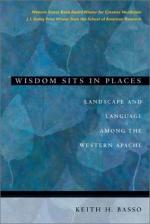|
This section contains 969 words (approx. 3 pages at 400 words per page) |

|
Chapter 3, Speaking With Names Summary and Analysis
Ethnographers immersed in a foreign culture with a foreign language must be cautious and understanding that the local conceptions of external realities are created from cultural concepts. Thus, when ethnographers become familiar with the local landscape, they must become familiar with local symbolism. Local peoples relate themselves to their geography in three ways: (i) through observing it, (ii) through using it, and (iii) by communicating about it. Understanding the landscape is partially a matter of understanding language and to glean from language the shared ideas of that culture. Often tacit messages are conveyed. The landscape is used to expand the imagination.
These shared meanings and geographies can only be studied through the study of property names and place-naming, in Basso's view. Place-names generate a wide range of cognitive associations, say with the mind, emotions, time...
(read more from the Chapter 3, Speaking With Names Summary)
|
This section contains 969 words (approx. 3 pages at 400 words per page) |

|




